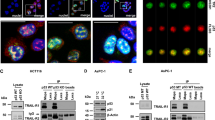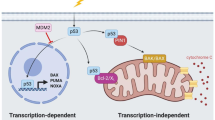Abstract
Tumor-associated mutant forms of p53 can exert an antiapoptotic gain of function activity, which probably confers a selective advantage upon tumor cells harboring such mutations. We report that mutant p53 suppresses the expression of the CD95 (Fas/APO-1) gene, encoding a death receptor implicated in a variety of apoptotic responses. Moderate (40–50%) downregulation of CD95 mRNA and surface protein expression by mutant p53 correlates with partial protection against CD95-dependent cell death. Excess mutant p53 represses the transcriptional activity of the CD95 promoter, with the extent of repression varying among different tumor-associated p53 mutants. Furthermore, mutant p53 protein binds the CD95 promoter in vitro, in a region distinct from the one implicated in tight interactions of the CD95 gene with wild-type p53. Hence, the CD95 promoter is likely to be a direct target for downregulation by mutant p53. This activity of mutant p53 may contribute to its gain of function effects in oncogenesis.
This is a preview of subscription content, access via your institution
Access options
Subscribe to this journal
Receive 50 print issues and online access
$259.00 per year
only $5.18 per issue
Buy this article
- Purchase on Springer Link
- Instant access to full article PDF
Prices may be subject to local taxes which are calculated during checkout






Similar content being viewed by others
References
Albor A, Kaku S and Kulesz-Martin M . (1998). Cancer Res., 58, 2091–2094.
Bailon P, Ehrlich G, Fung W and Berthold W . (2000). Methods in Molecular Biology, Vol. 147. Humana Press: Totowa, pp. 41–49.
Bargonetti J and Manfredi JJ . (2002). Curr. Opin. Oncol., 14, 86–91.
Blandino G, Levine AJ and Oren M . (1999). Oncogene, 18, 477–485.
Boldrini L, Faviana P, Pistolesi F, Gisfredi S, Di Quirico D, Lucchi M, Mussi A, Angeletti CA, Baldinotti F, Fogli A, Simi P, Basolo F and Fontanini G . (2001). Oncogene, 20, 6632–6637.
Cadwell C and Zambetti GP . (2001). Gene, 277, 15–30.
Chin KV, Ueda K, Pastan I and Gottesman MM . (1992). Science, 255, 459–462.
Deb S, Jackson CT, Subler MA and Martin DW . (1992). J. Virol., 66, 6164–6170.
Di Como CJ, Gaiddon C and Prives C . (1999). Mol. Cell. Biol., 19, 1438–1449.
Dittmer D, Pati S, Zambetti G, Chu S, Teresky AK, Moore M, Finlay C and Levine AJ . (1993). Nat. Genet., 4, 42–46.
el-Deiry WS . (1998). Semin. Cancer. Biol., 8, 345–357.
el-Deiry WS, Kern SE, Pietenpol JA, Kinzler KW and Vogelstein B . (1992). Nat. Genet., 1, 45–49.
Embree-Ku M, Venturini D and Boekelheide K . (2002). Biol Reprod., 66, 1456–1461.
Fanslow WC, Srinivasan S, Paxton R, Gibson MG, Spriggs MK and Armitage RJ . (1994). Semin. Immunol., 6, 267–278.
Frazier MW, He X, Wang J, Gu Z, Cleveland JL and Zambetti GP . (1998). Mol. Cell Biol., 18, 3735–3743.
Friesen C, Herr I, Krammer PH and Debatin KM . (1996). Nat. Med., 2, 574–577.
Gaiddon C, Lokshin M, Ahn J, Zhang T and Prives C . (2001). Mol. Cell Biol., 21, 1874–1887.
Gualberto A, Aldape K, Kozakiewicz K and Tlsty TD . (1998). Proc. Natl. Acad. Sci. USA, 95, 5166–5171.
Halevy O, Michalovitz D and Oren M . (1990). Science, 250, 113–116.
Harbour JW and Dean DC . (2000). Genes Dev., 14, 2393–2409.
Irwin M, Marin MC, Phillips AC, Seelan RS, Smith DI, Liu W, Flores ER, Tsai KY, Jacks T, Vousden KH and Kaelin Jr WG . (2000). Nature, 407, 645–648.
Kremenetskaya OS, Logacheva NP, Baryshnikov AY, Chumakov PM and Kopnin BP . (1997). Oncol. Res., 9, 155–166.
Li R, Sutphin PD, Schwartz D, Matas D, Almog N, Wolkowicz R, Goldfinger N, Pei H, Prokocimer M and Rotter V . (1998). Oncogene, 16, 3269–3277.
Lin JY, Chen JD, Elenbaas B and Levine AJ . (1994). Genes Dev., 8, 1235–1246.
Liu G, McDonnell TJ, Montes de Oca Luna R, Kapoor M, Mims B, El-Naggar AK and Lozano G . (2000). Proc. Natl. Acad. Sci. USA, 97, 4174–4179.
Lotem J and Sachs L . (1995). Proc. Natl. Acad. Sci. USA, 92, 9672–9676.
Marin MC, Jost CA, Brooks LA, Irwin MS, O'Nions J, Tidy JA, James N, McGregor JM, Harwood CA, Yulug IG, Vousden KH, Allday MJ, Gusterson B, Ikawa S, Hinds PW, Crook T and Kaelin Jr WG . (2000). Nat. Genet., 25, 47–54.
Matas D, Sigal A, Stambolsky P, Milyavsky M, Weisz L, Schwartz D, Goldfinger N and Rotter V . (2001). EMBO J., 20, 4163–4172.
Michael D and Oren M . (2002). Curr. Opin. Genet. Dev., 12, 53–59.
Michalovitz D, Halevy O and Oren M . (1991). J. Cell Biochem., 45, 22–29.
Muller M, Strand S, Hug H, Heinemann EM, Walczak H, Hofmann WJ, Stremmel W, Krammer PH and Galle PR . (1997). J. Clin. Invest., 99, 403–413.
Muller M, Wilder S, Bannasch D, Israeli D, Lehlbach K, Li-Weber M, Friedman SL, Galle PR, Stremmel W, Oren M and Krammer PH . (1998). J. Exp. Med., 188, 2033–2045.
Munsch D, Watanabe-Fukunaga R, Bourdon JC, Nagata S, May E, Yonish-Rouach E and Reisdorf P . (2000). J. Biol. Chem., 275, 3867–3872.
Murphy KL, Dennis AP and Rosen JM . (2000). FASEB J., 14, 2291–2302.
Newton K and Strasser A . (2000). J. Exp. Med., 191, 195–200.
O'Connor L, Harris AW and Strasser A . (2000). Cancer Res., 60, 1217–1220.
Offer H, Wolkowicz R, Matas D, Blumenstein S, Livneh Z and Rotter V . (1999). FEBS Lett., 450, 197–204.
Owen-Schaub LB, Zhang W, Cusack JC, Angelo LS, Santee SM, Fujiwara T, Roth JA, Deisseroth AB, Zhang WW, Kruzel E and Radinsky R . (1995). Mol. Cell Biol., 15, 3032–3040.
Peled A, Zipori D and Rotter V . (1996). Cancer Res., 56, 2148–2156.
Ryan KM, Phillips AC and Vousden KH . (2001). Curr. Opin. Cell Biol., 13, 332–337.
Sampath J, Sun D, Kidd VJ, Grenet J, Gandhi A, Shapiro LH, Wang Q, Zambetti GP and Schuetz JD . (2001). J. Biol. Chem., 276, 39359–39367.
Serrano M . (2000). Carcinogenesis, 21, 865–869.
Shao RG, Cao CX, Nieves-Neira W, Dimanche-Boitrel MT, Solary E and Pommier Y . (2001). Oncogene, 20, 1852–1859.
Sigal A and Rotter V . (2000). Cancer Res., 60, 6788–6793.
Soussi T . (2000). Ann NY Acad Sci., 910, 121–137; discussion 137–139.
Strano S, Fontemaggi G, Costanzo A, Rizzo MG, Monti O, Baccarini A, Del Sal G, Levrero M, Sacchi A, Oren M and Blandino G . (2002). J. Biol. Chem., 277, 18817–18826.
Strano S, Munarriz E, Rossi M, Cristofanelli B, Shaul Y, Castagnoli L, Levine AJ, Sacchi A, Cesareni G, Oren M and Blandino G . (2000). J. Biol. Chem., 275, 29503–29512.
Strauss BE and Haas M . (1995). Biochem. Biophys. Res. Commun., 217, 333–340.
Vogelstein B, Lane D and Levine AJ . (2000). Nature, 408, 307–310.
Volkmann M, Schiff JH, Hajjar Y, Otto G, Stilgenbauer F, Fiehn W, Galle PR and Hofmann WJ . (2001). J. Mol. Med., 79, 594–600.
Walczak H and Krammer PH . (2000). Exp. Cell Res., 256, 58–66.
Wang XJ, Greenhalgh DA, Jiang A, He D, Zhong L, Brinkley BR and Roop DR . (1998). Mol. Carcinog., 23, 185–192.
Weinmann AS and Farnham PJ . (2002). Methods, 26, 37–47.
Yang X, Pater A and Tang SC . (1999). Oncogene, 18, 4546–4553.
Zastawny RL, Salvino R, Chen JM, Benchimol S and Ling V . (1993). Oncogene, 8, 1529–1535.
Acknowledgements
We thank B Vogelstein and W Kaelin for p53 expression plasmids and S Benchimol for the ecotropic receptor expression plasmid. This work was supported in part by Grants QLG1-1999-00273 and QLK6-2000-00159 from the European Commission, and by grants from the Cooperation Program in Cancer Research of the DKFZ and Israel's Ministry of Science (MOS), the German-Israel Project Cooperation (DIP), the Kadoorie Charitable Foundations, and the Yad Abraham Center for Cancer Diagnosis and Therapy.
Author information
Authors and Affiliations
Corresponding author
Rights and permissions
About this article
Cite this article
Zalcenstein, A., Stambolsky, P., Weisz, L. et al. Mutant p53 gain of function: repression of CD95(Fas/APO-1) gene expression by tumor-associated p53 mutants. Oncogene 22, 5667–5676 (2003). https://doi.org/10.1038/sj.onc.1206724
Received:
Revised:
Accepted:
Published:
Issue Date:
DOI: https://doi.org/10.1038/sj.onc.1206724
Keywords
This article is cited by
-
Loss of LZAP inactivates p53 and regulates sensitivity of cells to DNA damage in a p53-dependent manner
Oncogenesis (2017)
-
Das hepatozelluläre Karzinom
Der Gastroenterologe (2016)
-
Anti-Apoptotic NF-κB and “Gain of Function” mut p53 in Concert Act Pro-Apoptotic in Response to UVB+IL-1 via Enhanced TNF Production
Journal of Investigative Dermatology (2015)
-
Mutant p53-R273H mediates cancer cell survival and anoikis resistance through AKT-dependent suppression of BCL2-modifying factor (BMF)
Cell Death & Disease (2015)
-
p53-dependent Fas expression is critical for Ginsenoside Rh2 triggered caspase-8 activation in HeLa cells
Protein & Cell (2014)



